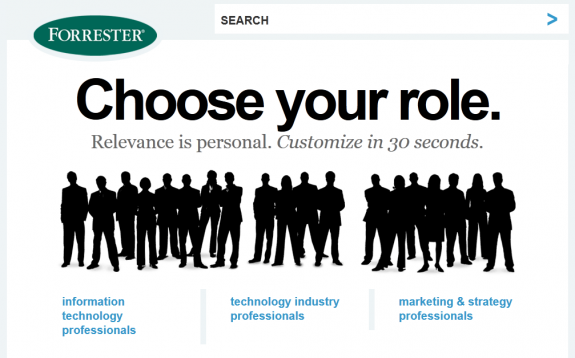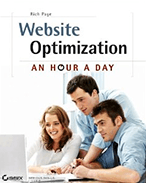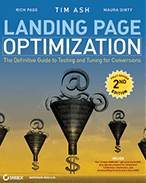How to Better Captivate and Engage your Homepage Visitors (in Less than 5 seconds!)
Last updated |
Recent studies have shown that you have just FIVE seconds to engage and influence a new visitor to stay on your website. They will judge your whole website (often unfairly) in those 5 seconds just from looking at your homepage – much in the same way that people judge a book by its cover in a matter of seconds. And if you don’t captivate and engage them very well quickly, they often won’t convert for your website goals (like orders or signups), or worst still, will bounce from your website immediately!
So how can you better engage these new homepage visitors to stick around and hopefully convert for your website goals? Ultimately it’s all about providing focus, value and personalization on your homepage. Let’s explore this in more detail…
First figure out what needs improving most!
First of all you need to figure just how your homepage is being judged, and your visitor’s initial reaction to it. This will help you find out what issues your homepage has and what needs testing and optimizing most. You can do this in three simple ways – try using FiveSecondTest.com to find out what your visitors instant homepage perceptions are. You should also run visual analysis on your homepage to figure out what visitors are clicking on (and looking at) – often much different than you might expect! You can then use a web survey tool like SurveyMonkey to ask visitors what they think of your homepage (but only after they have had a chance to look at it!).
Doing this analysis will give you some great ideas as to what you need to test improving/re-arranging on your homepage so that it better engages and converts new visitors within 5 seconds.
How to better engage your homepage visitors
Regardless of what type of website you have, there are some universal best practices to employ on your homepage to engage and convert your visitors better.
- Clearly show your unique value proposition above the page fold. Ultimately you need to show what visitors can do on your website, and convince them why they should do it with yours as opposed to a competitors website – this is known as your unique value proposition. This is best shown in one of your homepage modules above the page fold. Try making use of bullet points to make it short and sweet – makes it easier to scan and understand. Show it in one of your early slides of your content slider if you have one. And if you don’t have a good value proposition already, spend some time focusing on this – if you don’t know it, how do you expect your visitors to?
- Create major site use cases & be sure your homepage solves for them. If your website doesn’t easily solve the main needs of your visitors, they will be gone, likely to one of your competitors who does a better job. So go ahead and rank the most important tasks (use cases) that your visitors will want to do from your homepage, and make sure you have options to meet their most important needs, clearly shown about the page fold. This is best often achieved by showing large call-to-action buttons relating to each major use case. A great way to test if your homepage is solving for these needs is to use a tool like Loop11.com that allows you to run task completion rate analysis on your visitors. My favorite example of a homepage that solves for users main needs is the Forrester homepage, which focuses on three call-to-actions to allow the visitor to define who they are, which then personalizes the rest of the website.

- Cut out the clutter and focus it better! No one likes being overwhelmed with choices or too much content screaming for attention. Homepages are no different – but unfortunately they often turn into marketing dumping grounds, filled with largely irrelevant information from multiple departments competing for your attention – a sure fire way to have your visitors bounce in droves from your homepage! To make sure your homepage isn’t guilty of this, you should run exclusion tests to figure out which page elements have low influence on conversion and engagement, and then consider removing these unhelpful elements. Ultimately your homepage should act as a springboard for your visitors to quickly get deeper into the area of your website that interests them the most (and the Forrester example above works great for this too!) This will give your bounce rates a great improvement in particular.
- Make your content load much quicker. No one likes slow loading web pages – that’s where this 5 second rule comes in again – if your homepage doesn’t load in that time, your visitors will often abandon it, more than likely to a competitor whose content loads quicker. Even Google doesn’t like slow loading pages now – they will penalize your website in their rankings if your homepage loads too slowly. So go ahead and check how fast your homepage loads – you can now even do this in a new report in Google Analytics, and then use a tool like YSlow to figure out elements are slow loading that need optimizing. Simple things to speed up load times involve reducing image sizes, making your code more efficient and also recreating slow loading dynamic elements in simpler faster loading HTML5 code. And this is even more appropriate for websites browsed on mobile phones, where connection speeds are much slower (build an optimized mobile website to help with this).
- Lastly, and most importantly, personalize it! In today’s highly consumer driven world, customization and personalization is essential to boost revenue and remain competitive, and the same applies for websites too. Don’t just have a ‘one-size-fits-all’ website and homepage that tries to meet the needs of everyone at the same time! To do this personalization in its simplest form, run targeting on your homepage to show relevant content to new visitors (a new user guide, top benefits for using your site etc). This way you don’t waste valuable real estate space on your homepage showing information that is more suited to repeat visitors. This targeting can be done by most major testing tools like Test&Target (even BTbuckets allows you to do a basic form of this for free). Then you can use this same targeted space again when visitors come back with relevant content or products relating to categories they have most often seen on your website. Targeting personalized content is often very effective for increasing engagement and conversion rates, and has worked very well for many client websites.
So there we have it. Some great ways to better engage and convert your homepage visitors in less than 5 seconds. Which ones are you currently doing on your homepage – comment below so we can discuss!
Don’t forget you can also learn more ways to test and optimize your homepage and other key pages in my new website testing and optimization book.



